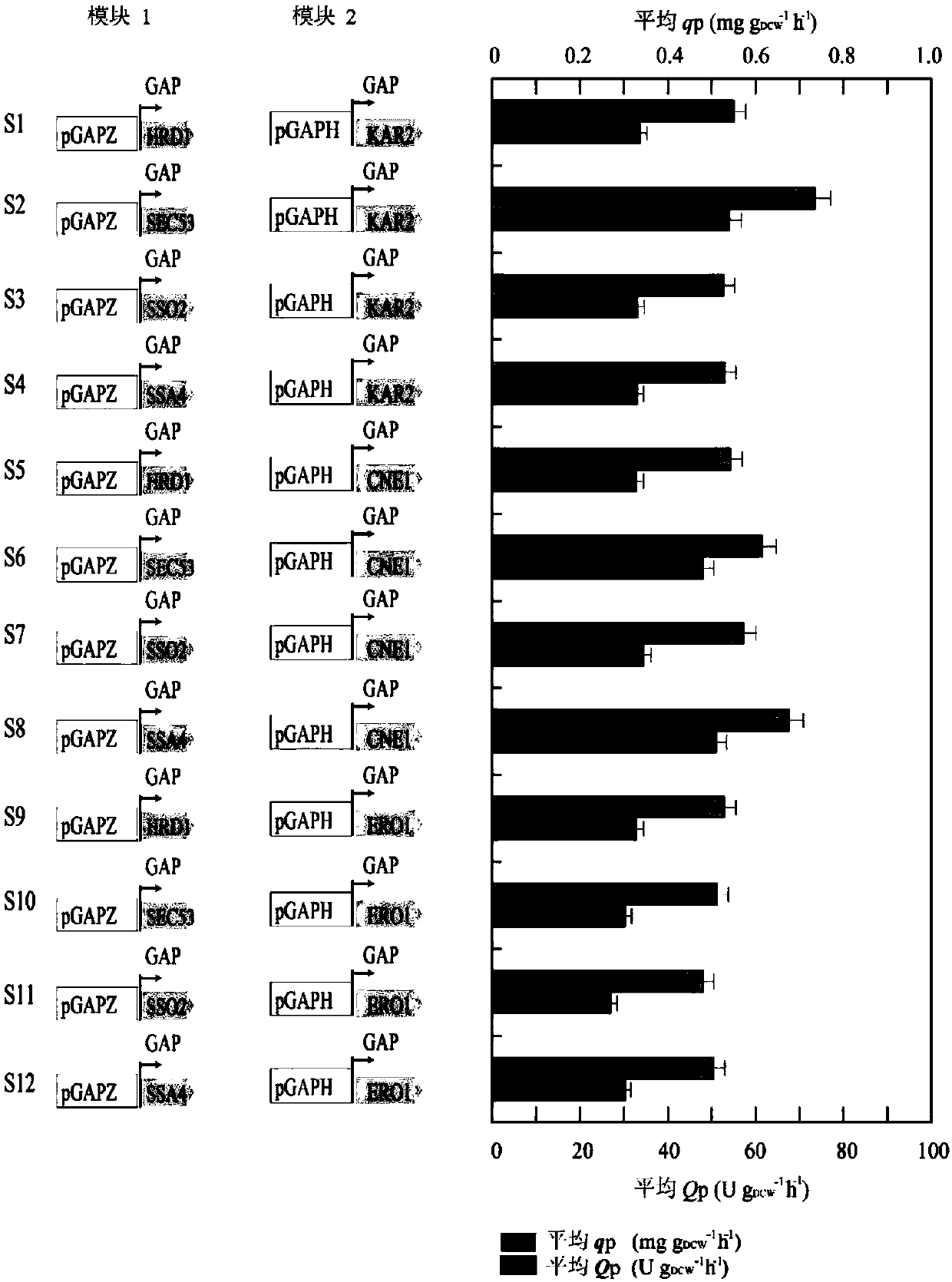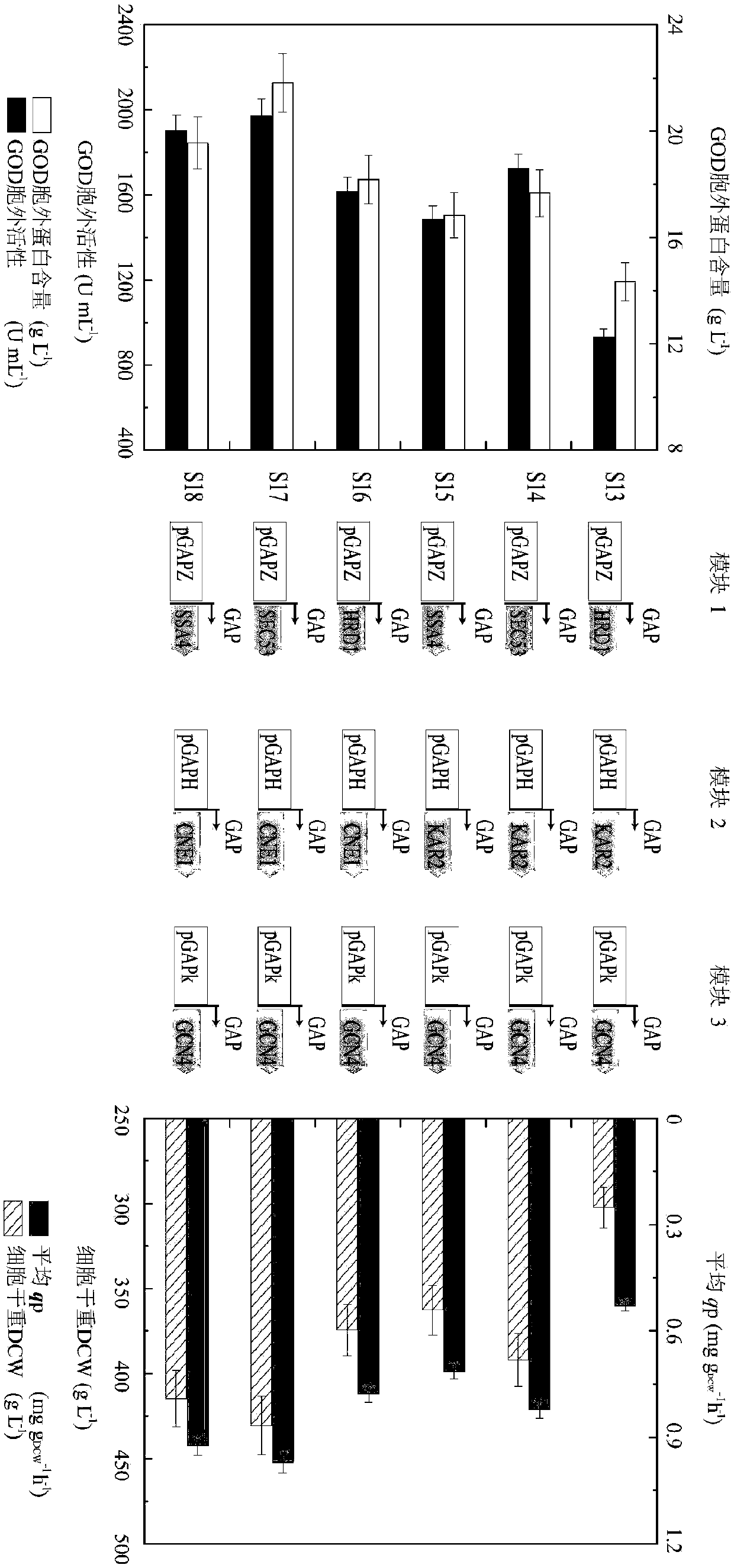Method for enhancing glucose oxidase secretion through transforming folding and secreting pathway of protein
A glucose oxidase and protein technology, applied in the field of genetic engineering, can solve problems such as high cost and complicated separation and extraction
- Summary
- Abstract
- Description
- Claims
- Application Information
AI Technical Summary
Problems solved by technology
Method used
Image
Examples
Embodiment 1
[0041] Embodiment 1 The influence of each different module gene on the secretion of glucose oxidase
[0042] 1.1 The effect of the folding module genes in the modified endoplasmic reticulum on the exogenous expression of GOD
[0043] The protein folding rate in the endoplasmic reticulum (ER) and the secretion rate in the cytoplasm are important factors affecting the secretion of exogenous proteins in yeast cells. The resident proteins Kar2p, Cne1p and Ero1p involved in the protein folding mechanism in the ER can help the nascent unfolded peptide chain to fold into the correct conformation. In order to study the effect of the ER folding module on the secretion of exogenous GOD, the ER resident protein coding genes KAR2, CNE1 and ERO1 in P. pastoris were overexpressed in the P. pastoris engineering strain PP-GOD to enhance the transformation of the engineered strain cells. The expression levels of the corresponding functional proteins within are shown in Table 3. After co-expr...
Embodiment 2
[0062] Example 2 Effect of protein secretion pathway module optimization on exogenously expressed glucose oxidase
[0063] The co-expression of each module gene in Example 1 can improve the production of GOD in recombinant P. pastoris, which indicates that each module can be modified to secrete exogenous GOD from P. pastoris. In order to further improve the ability of recombinant P. pastoris to produce exogenous GOD, the influence of the optimized combination of each module gene on the ability to produce exogenous GOD was studied. Due to the interconnection between each functional block, simply superimposing the functional module genes in a functional block cannot make the result show an additive increase. Therefore, in this example, the genes of different functional modules are combined with each other through modular optimization and transformation, so as to further improve the production of exogenous GOD by recombinant P. pastoris. The functional genes in Example 1 are div...
Embodiment 3
[0071] Example 3 Effect of Modular Transformation on Intracellular Active Oxygen Levels of Pichia pastoris
[0072] The changes of intracellular ROS and cell growth of the recombinant strain S17 were investigated by flow cytometry. Since the use of methanol will also have an impact on the accumulation of intracellular ROS, the wild-type GS115 strain was also compared as a control strain. Such as Figure 4 As shown, after transformation, the cell survival rate of the S17 strain was significantly improved, and the cell survival rate reached 77.4% after 144 hours of fermentation, which was 16.6% higher than that of the original strain PP-GOD. Through the detection of intracellular ROS levels, it was found that due to the induction by methanol, the bacteria will also produce ROS while using methanol to increase the level of ROS in the cells, such as Figure 4 As shown in B, the number of cells with high ROS levels in the control strain GS115 increased as the induction time prolo...
PUM
 Login to View More
Login to View More Abstract
Description
Claims
Application Information
 Login to View More
Login to View More - Generate Ideas
- Intellectual Property
- Life Sciences
- Materials
- Tech Scout
- Unparalleled Data Quality
- Higher Quality Content
- 60% Fewer Hallucinations
Browse by: Latest US Patents, China's latest patents, Technical Efficacy Thesaurus, Application Domain, Technology Topic, Popular Technical Reports.
© 2025 PatSnap. All rights reserved.Legal|Privacy policy|Modern Slavery Act Transparency Statement|Sitemap|About US| Contact US: help@patsnap.com



